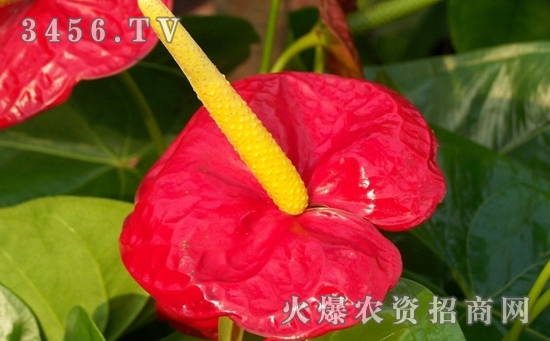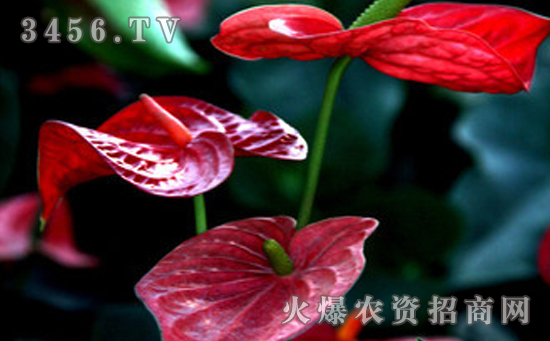How to prevent anthracnose of Anthurium andraeanum?
The disease is caused by a semi-known fungal fungus of Colletotrichum. The pathogen survived the winter in the diseased tissue or basin with mycelium and conidia, carried out primary infection and re-infection with conidia, and spread by Rain Water sputtering and small insect activity. Usually warm and humid weather and ecological environment can easily cause the disease.
Symptoms: the main harm to the leaves, the leaves produce round brown disease spots, mostly along the veins, the disease spot fusion to form a larger brown plaque, the edge is yellowish brown, and then the disease spot dries and falls off.
Prevention and cure method: ① is carefully nursed. Anthurium andraeanum likes high temperature and high humidity environment, the suitable temperature for growth is 20-30 ℃, the air relative humidity is more than 85%, and the light should not be too strong. Apply thin fertilizer once a month during the growing season. In addition to normal watering, you should spray water once or twice a day, but do not spray water in the mouth of the inflorescence trumpet. Move into the weak light of the greenhouse in October or use the sunshade net to control watering properly. The diseased leaves found by ② should be cut off and destroyed in time. ③ sprays 1% potassium dihydrogen phosphate solution to the leaves every 15 days to improve disease resistance. During the onset of ④, 25% trimethoprim wettable powder or 1000 times anthrax Fumi wettable powder should be sprayed, once every 10 to 15 days, and 3 times for 4 times.
How to control anthracnose of Anthurium andraeanum
Anthurium andraeanum is one of the most valuable flowers in the world. it has a long flowering period and can be raised in water for up to one and a half months. at the same time, it is a potted plant planted by many families because of its bright color and rich color. Anthurium andraeanum does not have high requirements for the cultivation environment, but it is also easy to get sick if it is not managed properly. Anthracnose is a common disease of Anthracnose. How to prevent anthracnose? The editor will study with you today.

Anthracnose of Anthurium andraeanum is caused by a semi-known fungus of anthracnose. The pathogen survived the winter in the diseased tissue or basin with mycelium and meristematic embracing disk. The primary infection and re-infection were carried out with dichotomous seeds, and spread by Rain Water sputtering and small insect activities. Usually warm and humid weather and ecological environment can easily cause the disease.
Anthracnose symptoms of Anthurium andraeanum
Anthracnose of Anthurium andraeanum mainly harms leaves. Round brown spots appear on the leaves. It often occurs along the vein of the leaf, and when the condition is serious, the disease spot fuses to form a large brown plaque. The edge is yellowish brown, and then the disease spot dries up and falls off.
Prevention and control of anthracnose of Anthurium andraeanum
① takes good care of her. Anthurium andraeanum likes high temperature and humidity. The suitable temperature for growth is 20-300C, the air relative humidity is more than 85%, and the light should not be too strong. Apply thin fertilizer once a month during the growing season. In addition to normal watering, you should spray water 1-2 times a day, but do not spray water in the mouth of the inflorescence trumpet. Move to the weak light in the greenhouse or use the sunshade net in October to properly control watering. The diseased leaves found by ② should be cut off and destroyed in time. ③ every other day or so, spray 1 intestinal potassium dihydrogen phosphate solution to the leaf to improve disease resistance. During the onset of ④, spray 25% carbendazim wettable powder or anthrax Fumei wettable powder 1000 times, once every 10 ^-15 days, prevention and treatment 3-4 times.
So much for the prevention and control of anthracnose in Anthurium andraeanum. Anthurium andraeanum can be used as a cut flower, the Buddha flame bud is huge, the color is red, pink, white, green, two-color and so on, which is very festive and implies a grand plan. Planting at home should pay attention to Anthurium andraeanum like wet, cool environment, keep the indoor environment good, avoid too dry, the soil is too dry.
Symptoms and control methods of anthracnose of Anthurium andraeanum
Symptoms: also known as black nose, inflorescence rot, fungal spot disease. The main harm to the leaves, the initial production of round brown disease spots, mostly along the veins, when the disease is serious, the disease spot fusion to form a large brown spot, the edge of yellowish brown, and then dry off; inflorescence rot caused by Anthurium andraeanum, resulting in black necrotic spots.
Pathogen: the pathogen is Colletotrichum gloeosporioides (Penz.) ) Sacc. It can infect many kinds of plants, such as apple, Robinia pseudoacacia, banana, chrysanthemum, tortoise back bamboo, variable leaf wood and so on. The pathogen survived the winter with mycelium and conidia disk in diseased tissue or cultivation substrate, carried out primary infection and re-infection with conidia, and spread by Rain Water sputtering and insect activity. Warm and humid weather and ecological environment are conducive to the occurrence and prevalence of diseases; improper watering methods or small wounds on leaves are prone to disease; rainy or high temperature and high humidity last for a long time. Control method: cultivation control: because anthracnose is produced in the environment of high temperature and humidity. Therefore, try to control the humidity in the greenhouse, especially at night. The partial application of high potassium, high calcium and high magnesium fertilizer is beneficial to improve the disease resistance of the plant. Chemical control: preventive agents: methyl suspension > chlorothalonil suspension > Dyson suspension > sulfur or copper fungicides: prochloraz manganese salt > prochloraz > tebuconazole > difenoconazole > flusilazole > other azoles > carbendazim
Related topic: Anthurium andraeanum cultivation
- Prev

How to control Anthurium andraeanum leaf mildew?
Anthurium andraeanum leaf mildew is caused by half-known fungi. The pathogen overwintered with hyphae or conidia in the diseased part or on the soil surface with the disease residue. It was weak parasitic bacteria, mostly secondary parasitic bacteria or saprophytic bacteria, which often appeared on the senescent leaves, and the plant expanded rapidly in the later stage of plant growth. In production
- Next

Prevention and control of diseases and insect pests of Anthurium andraeanum flowers, how to remedy aphids and how to treat aphids when the leaves of Anthurium andraeanum turn yellow
Anthracnose and root rot are common diseases of Anthurium andraeanum. Anthracnose harms twigs and leaves, and the infected parts first appear watery spots, which are round or nearly round, showing dark brown. Subsequently, the lesion continues to expand, showing wheel lines, and the central part becomes light brown or grayish white.
Related
- Fuxing push coffee new agricultural production and marketing class: lack of small-scale processing plants
- Jujube rice field leisure farm deep ploughing Yilan for five years to create a space for organic food and play
- Nongyu Farm-A trial of organic papaya for brave women with advanced technology
- Four points for attention in the prevention and control of diseases and insect pests of edible fungi
- How to add nutrient solution to Edible Fungi
- Is there any good way to control edible fungus mites?
- Open Inoculation Technology of Edible Fungi
- Is there any clever way to use fertilizer for edible fungus in winter?
- What agents are used to kill the pathogens of edible fungi in the mushroom shed?
- Rapid drying of Edible Fungi

